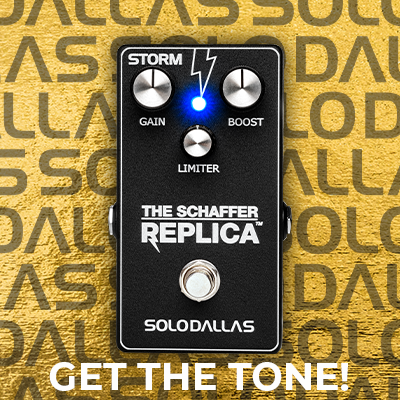“I don’t know if I’ve found a drive that I like as much as this one.” — Tanner Erickson
At SoloDallas, we build pedals for serious players—and when a working bassist like Tanner Erickson calls the BASS-X “absolutely killer,” we take that seriously. In his full-length demo, Tanner breaks down exactly why this analog powerhouse has earned a permanent place on his pedalboard—and why it’s redefining what bass drive can sound like.
The BASS-X: Built Different
Tanner starts by walking us through the specs that set the BASS-X apart. It’s 100% analog and shares the DNA of our legendary Storm pedal—our Schaffer Replica for guitar—but voiced specifically for the bass guitar. The signal path is inspired by the original Schaffer-Vega Diversity System, used on countless iconic records throughout the '70s and '80s.
With a lineup of internal features including an interactive optical limiter, EQ expander, harmonic clipping circuit, clean boost, and line buffer, the BASS-X is more than a drive—it’s a fully integrated tone-shaping engine.
“It gives me that really punchy, aggressive mid-range that I’m going for.”
Three Knobs, Infinite Possibilities
The BASS-X keeps your signal chain simple without sacrificing flexibility. Tanner breaks down each control:
-
Gain: Our signature clipping circuit that emphasizes low-mid frequencies for rich, musical overdrive.
-
Boost: A clean preamp boost offering up to +31 dB—perfect for leads or amp saturation.
-
Limiter: An analog optical limiter that naturally reigns in your peaks without killing dynamics. According to Tanner, this is the pedal’s “secret weapon.”
Overdrive vs. Distortion: Know the Difference
Tanner makes an important distinction: “Overdriven tone is substantially better than a distorted tone.” Why? Overdrive mimics the feel of a tube amp at the edge of breakup—organic, dynamic, and touch-sensitive. Distortion, in contrast, often feels compressed and harsh.
The BASS-X nails that amp-pushed sound, even when you’re going direct. Whether you’re layering it into a pedal-based rig or sending it into a preamp like the Aguilar Tone Hammer (as Tanner does), it keeps your low end tight and your mids punchy.
Real-World Playability
One of the highlights of Tanner’s demo is how clearly he outlines real-world tone sculpting:
-
He starts with the gain and boost at noon, then varies the limiter to show how it tightens or opens the tone.
-
Then he explores combinations of maxed gain, maxed boost, and different limiter positions, giving you a taste of the pedal’s incredible versatility.
-
Finally, he shares his personal settings: Limiter at 11 o'clock, boost maxed, and gain just past 3 o'clock—a mix of saturation and clean headroom that fits right into a live mix.
“I think of the limiter like compression—it keeps everything in a nice little organized box.”
Always-On or Feature Drive? You Decide.
Though originally curious about using the BASS-X as an always-on tone enhancer, Tanner found it truly shines as a drive pedal in his rig. But the beauty of the BASS-X is that it can be either—or both.
Final Thoughts
Tanner sums it up perfectly: “This pedal does all that and more.” Whether you’re into rock, funk, metal, or modern worship music, the BASS-X is a serious tool for serious bassists. Add it to your rig, and like Tanner, you just might find your perfect drive.


